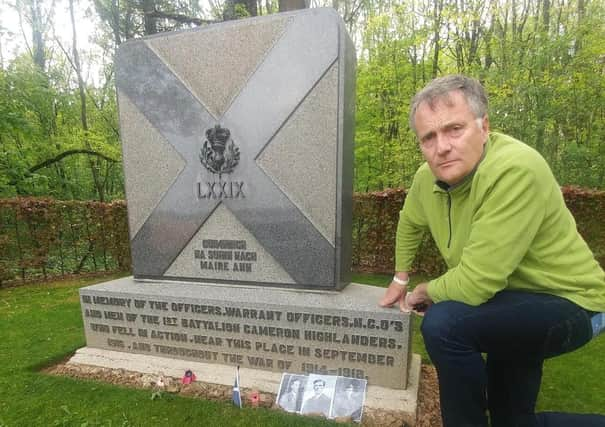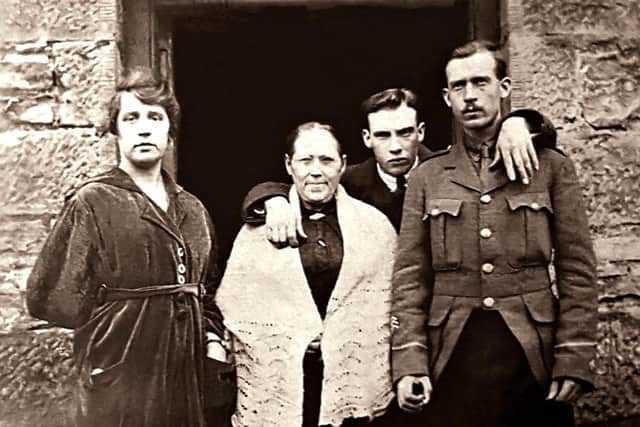Laxdale soldier returned home a broken man


It was also the first time when a new and bizarre injury was showing up on the battleground. The symptoms were wide-ranging, from incessant ringing in the ears to headaches and physical tremors. And many were suffering.
By December of 1914, just five months into the war, it was estimated that 10 per cent of allied officers and four per cent of enlisted men were suffering from some form of this curious new injury.
Advertisement
Hide AdAdvertisement
Hide AdA private with the Cameron Highlanders, my great uncle Donald fell victim to this condition on his first tour of duty.


Born in Laxdale, Isle of Lewis, Donald was just 18 years old when he saw action at the Battle of Loos. The largest British attack of 1915, Loos started as a massive assault on German defences and ultimately ended in defeat for the allies.
Donald came off the battlefield with no apparent injuries beyond a paralysed right arm. Doctors were stumped. This type of injury was showing up by the thousands. Speculation ran wild.
The term ‘shell shock’ grew out of the first round of speculation. Doctors assumed there had to be a link between the symptoms and effects of exploding artillery shells. Some doctors went further and believed some form of hidden physical damage had been inflicted upon the brain.
Advertisement
Hide AdAdvertisement
Hide AdRemarkably, they weren’t far off the mark. We now understand the complexities of the condition known as PTSD. Recent studies have also found a physical component as well.
Researchers at Johns Hopkins University learned that soldiers exposed to improvised explosive devices (IEDs) have shown a pattern of brain injury that affects decision-making, memory and reasoning.
Sadly, in 1915, there was no time to press pause and understand what was happening and treat injured soldiers. Panic was setting in. Commanding officers were concerned that an epidemic was developing, threatening their ability to assemble enough soldiers to wage war.
To set an example — and whip men back into the trenches — shell shock was portrayed as a character flaw. Some injured soldiers were put on trial and executed for desertion and cowardice. Hundreds of soldiers experienced this cruel fate, finally being pardoned by the UK government in 2007.
Advertisement
Hide AdAdvertisement
Hide AdUncle Donald fortunately escaped this purge, at least briefly. He took a year to recover and spent months shuttling between hospitals in Scotland and England. Finally, a diagnosis was given. Donald’s injury fell into the category of acute ‘neurasthenia’, a strange word coined in the early 1800s to “describe a mechanical weakness of the brain”.
Between 60-80 per cent of shell shock cases were labelled as neurasthenia in 1915-16.
One year after his injury at Loos, my great uncle Donald was back in uniform, considered fit for battle. But his timing could not have been worse. He was about to get sucked into the maw of one of the bloodiest fights in history: the Battle of the Somme.
Less a battle than a series of attacks, the Somme offensive lasted from July to November 1916. More than three million men fought over four short months — and more than one million were killed or wounded.
Advertisement
Hide AdAdvertisement
Hide AdDonald entered the battle on September 3 at Bois des Foureaux or “High Wood”- an area of land no bigger than a big city park. It’s both morbid and fascinating to learn that High Wood would one day become a tourist attraction.
Twenty years after the battle, visitors could still see the detritus of war strewn over the ground: helmets, wire and weapons, tools and equipment, plus unexploded munitions and the bodies of over 8000 soldiers. They all remain there to this day, covered over by dirt, grass and trees.
Donald came out of the Battle of High Wood stricken once again; the psychological trauma of war had returned. But this time it would never go away. He remained permanently disabled. The few records that remain show he was pensioned out of the army and spent the rest of his life in the shadows.
For decades, home for uncle Donald was the wing of a military hospital in Glasgow. And there he stayed for close to 50 years. He died an old man in the 1970s, unknown to society — and many people in our family.
Advertisement
Hide AdAdvertisement
Hide AdI grew up having no idea Donald made it out of the war. And it pains me to think a family member suffered for so long in the margins of society. It’s also strange to speculate that Donald would have enjoyed greater respect and support had he simply lost an arm or leg.
But shell shock was a special type of injury; it scared people. Postwar society was unable and unwilling to discuss the horror of the Great War, much less try to understand or sympathise with soldiers suffering from mental health issues.
This article is a tribute to a man I never knew, a member of my family who disappeared from society after the war and treated as irrelevant his entire adult life. Lest we forget, shell shock has not faded into irrelevance. The term remains on the books, used to describe a very specific injury under the umbrella of PTSD.
During the US involvement in Iraq and Afghanistan, over 350,000 troops were diagnosed with shell shock, having sustained a brain injury from explosive weapons or devices.
There are an awful lot of Donald MacLeods around today.
“They shall grow not old, as we that are left grow old:
Age shall not weary them, nor the years condemn.
At the going down of the sun and in the morning
We will remember them.”